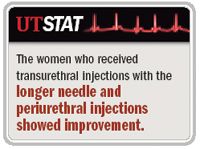Article
North American data: Autologous cells show promise in UI
Pittsburgh-North America has now entered the competition to treat urinary incontinence with autologous muscle-derived cells with a human trial in seven patients. The prize is actual reconstruction of continence mechanisms.


"It behaves differently in that it actually increased the contraction of the sphincter. We actually regenerated efficient sphincter muscle," Dr. Chancellor told Urology Times.
No acute adverse events
The trial was a safety study in seven patients led by Lesley Carr, MD, a urologist at Sunnybrook Health Science Center and assistant professor of urology at the University of Toronto. She and her team performed a percutaneous muscle biopsy of each patient, which was shipped to Cook MyoSite, a lab in Pittsburgh. Biopsies were processed with a preplating technique and expanded to 20 million cells, which were shipped back to Toronto.
In the first three patients, Dr. Carr and her team used cystoscopic, transurethral injections with an 8-mm needle. The investigators thought this initial approach was not able to deliver the cells deep enough into tissue to reach the striated sphincter, so they modified the technique to use a longer (10-mm) needle for the next two injections. The team further modified the technique for the remainder, using a simple, periurethral spinal needle approach to target the external sphincter-the same approach Dr. Chancellor and Dr. Carr have used to inject botulinum toxin A (Botox) for dyssynergia.
Through follow-up-the longest has been 18 months-there have been no acute or long-term adverse events. Three patients have been re-treated.
The women who received transurethral injections with the longer needle and periurethral injections showed improvement based on their bladder diary reports and in quality of life.
Larger human trials are due to begin soon. The Canadian regulatory agency has approved a multicenter trial, and the FDA has also approved a trial to be conducted in Pittsburgh, Dr. Chancellor said. Those trials, he hopes, will be done "in a year or 2."
Clearly enthusiastic about the potential of this therapy, Dr. Chancellor noted that muscle-derived cell injection has the potential, not only for incontinence because of intrinsic sphincter deficiency, but also for repairing damaged heart muscle-or any muscle.
"If you have your own stem cells, that's your little quasi fountain of youth," Dr. Chancellor said, pointing out the small lesion on his own leg where he had his cells harvested.
The idea that there is a "personal fountain of youth" in a vial in a refrigerator was one that gave the team willing volunteers for practice of the muscle biopsy technique.
"Who knows, in 20 years, we may all need it," said Dr. Chancellor. "The reason I'm excited about it is that it appears to be a very safe way to advance medical science."
Dr. Chancellor is a founder of and consultant to Cook MyoSite. Dr. Carr is a Cook MyoSite-sponsored principal investigator.





